The number of New Yorkers taking and passing the high school equivalency (HSE) exam has declined in virtually every corner of the state over the past five years, a troubling development at a time when today’s economy puts a premium on educational credentials. Indeed, workers in New York State without a high school credential are more than twice as likely to be unemployed as the average worker, and nearly one in three are living in poverty. But while one out of every eight adult New Yorkers—some 1.6 million residents between the ages of 18 and 64—lacks a high school diploma, our analysis of the latest high school equivalency testing data finds that too few New Yorkers are even signing up for the test and that the state’s already dismal high school equivalency pass rates have sunk even lower.
Our analysis finds ample cause for concern:
- Fewer New Yorkers are taking the test. The number of students taking a high school equivalency test dropped 46 percent between 2010 and 2015. Test-taking rates dropped 76 percent in Niagara County and 70 percent in Schenectady County.
- Unacceptably low pass rates have fallen further. The statewide pass rate, already among the nation’s lowest, dropped even further, from 60 percent in 2010 to 53 percent in 2015. The pass rate in Dutchess County dropped by 15 percentage points and by 13 percentage points in Onondaga and Albany Counties. Five counties have pass rates below 50 percent, four of which are boroughs of New York City. The lowest pass rate in 2015 was 40 percent in Bronx County.
- New York has a math problem. Pass rates on the math test dropped by 15 percent between 2010 and 2015, compared to only an average 4 percent drop in the other four tests. In 2015, just over half of test-takers passed the math subtest, suggesting that much of the falling pass rate may result from a more stringent math test.
- The share of adults earning an HSE has hit rock bottom. The share of adults ages 18-64 obtaining a high school equivalency fell by half, from 1.8 percent in 2010 to 0.9 percent in 2015.
For New Yorkers who have dropped out of high school, the first step toward a career is earning a high school equivalency diploma. For more than 60 years, that meant earning a General Education Development (GED) credential. But when the GED Testing Service announced that the 2014 edition would double in cost, switch from pencil and paper to computers, and take effect in a single year rather than being phased in over time, it became apparent that staying with the GED was about to become prohibitively expensive and potentially damaging to student aspirations. As a result, the New York State Department of Education (NYSED) put out a request for proposals that resulted in replacement of the GED with an entirely new test: the Test Assessing Secondary Completion (TASC).
New York had plenty of company in dropping the GED. Ten states replaced the GED with alternative high school equivalency tests and another 14 decided to offer other test options along with the GED. NYSED helped as many students as possible to complete the GED in 2013 and then switched to the TASC in 2014. Although New York almost certainly did the right thing in replacing the GED, early TASC results suggests that education officials and policymakers in the state need to take additional steps to ensure that many more New Yorkers can earn a high school equivalency—and with it, a shot at economic opportunity.
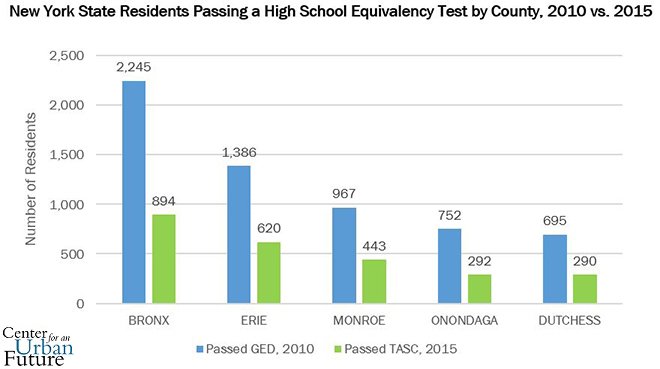
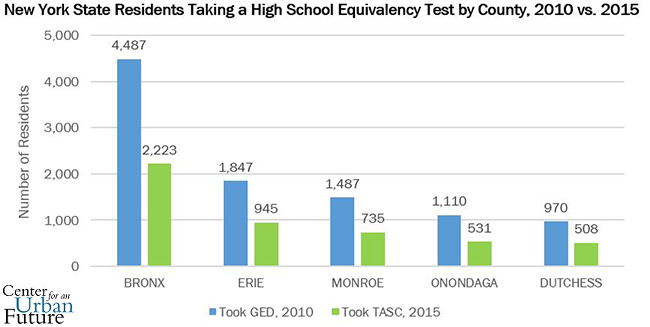
Among the key findings of our analysis:
The number of people taking and completing their high school equivalency exam has dropped significantly.
- Test completions fell drastically between 2010 and 2015. The number of students who took a high school equivalency test fell by 46 percent between 2010 and 2015, from 47,187 to 25,471 (see Figure 1).
- New York City accounts for more than half of all TASC test-takers statewide. Test completions dropped by 43 percent in the five boroughs, led by Staten Island, where test volume dropped by more than half (52 percent). But the numbers in some upstate counties fell even more steeply. Niagara County saw a 76 percent decline and Schenectady County dropped 70 percent. Monroe and Erie Counties—home to Rochester and Buffalo, respectively—both saw test-taking rates cut in half.
New York’s high school equivalency pass rate, among the nation’s lowest, fell even further.
- Using the GED test, New York’s pass rate in 2010 was just 60 percent, compared to a national average of 73 percent.
- Under the new TASC test, the state’s pass rate has dropped further. In 2014 and 2015, the statewide pass rates were 50 percent and 53 percent (see Figure 2). Other states have seen even steeper declines, including a drop of 24 percent in New Mexico. The GED Testing Service has yet to report pass rates in the states that continue to use its exam in either 2014 or 2015.
- In 2015, New York City had a pass rate of 46 percent. Of all counties in the state, the Bronx had the lowest pass rate at 40 percent. Manhattan’s 51 percent pass rate was the city’s highest, and the only borough to crack 50 percent, if only barely. Westchester and Nassau Counties had the lowest pass rates outside of New York City, at 49 percent and 51 percent.
- In two of the four years before 2014, New York had the lowest GED pass rate in the nation. In the other two years, it ranked 49th, slightly ahead of Mississippi.
- New York continues to fare poorly compared to other states using the TASC, but it does not have the absolute lowest pass rate. In 2015, New York ranked 14 out of 17 states that reported their pass rates on the TASC or HiSET tests. New Jersey had a 44 percent pass rate, the nation’s lowest reported rate (see Figure 3).
- Every year, the large number of New Yorkers who take their high school equivalency test without formal preparation drags down the pass rate. In 2015, test-takers who took a preparation course had a pass rate of 65 percent, while walk-in testers had a 45 percent pass rate. Both were down from 2010, when pass rates were 74 percent and 51 percent, respectively. Only 40 percent of testers in 2015 enrolled in a preparation course, consistent with past years (see Figure 4).
- The GED and the TASC use the same five subtests: writing, social studies, science, reading, and math. On average, the pass rate dropped by 6 percent between 2010 and 2015, from 78 percent to 72 percent. Math had the lowest pass rate in 2010 (68 percent), and that pass rate dropped much more steeply than other subtests – by 15 percentage points, compared to an average of 4 points for the other four subtests. As of 2015, just over half of test-takers passed the math subtest (53 percent). (See Figure 5).
New York is reaching a smaller share of adults who lack a high school diploma.
- In 2010, an average of 1.8 percent of adults in New York who lacked a high school diploma obtained one by passing the GED.
- In 2015, only 0.9 percent of New Yorkers lacking a high school diploma got one by passing the TASC, due to a combination of fewer test-takers and a lower pass rate.
To be sure, New York’s HSE pass rate is low for many reasons that are outside of NYSED’s control. By state law, New York cannot charge a fee to an HSE test taker, nor does New York require anyone to pass a readiness test before taking the TASC. As a result, many adults take the test with inadequate preparation. It is also worth pointing out that the decline in test taking and pass rates is a national problem, not one limited to New York. NYSED officials we interviewed argue that the test-taking decline is normal for a new HSE test and believes that the test-taking rate will rebound.
To its credit, NYSED is taking several steps to improve HSE testing and completion, including training HSE instructors to teach the more rigorous curricula required for successful TASC completion, collaborating with the TASC vendor to better align test questions with high school graduation requirements, and providing technical assistance to test centers. It’s clear, however, that more is needed. Given the growing expectation among employers that job applicants must have a high school credential, the outcomes of New York State’s HSE system continue to be cause for concern. Faced with declining participation and lagging pass rates, policymakers should support NYSED in its efforts to recruit more test takers, train instructors to teach more difficult material, and expand the availability of test preparation in counties from Onondaga to Queens.
New York’s outcomes might well have been worse had it stayed with GED. The GED Testing Service unnerved many in the field by unilaterally reducing the score needed to pass the GED, suggesting that pass rates may have been unacceptably low in some GED states. Furthermore, the GED Testing Service no longer publishes annual reports on state outcomes, unlike its competitors, TASC and HiSET. Sharp declines in testing and passing rates have been reported in Ohio, Kentucky, and Colorado. Despite its advantages over the GED, however, New York’s TASC test is still leaving far too many adults behind.

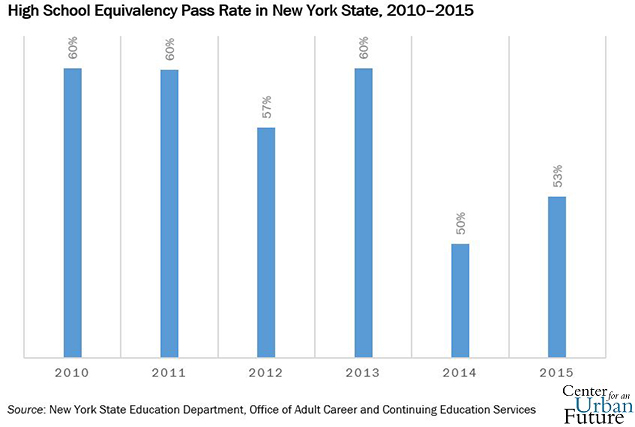
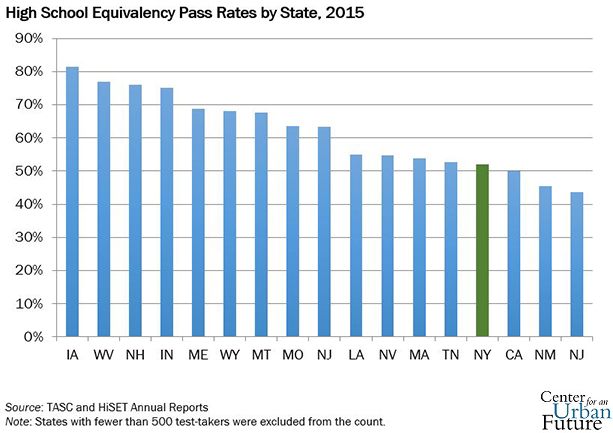
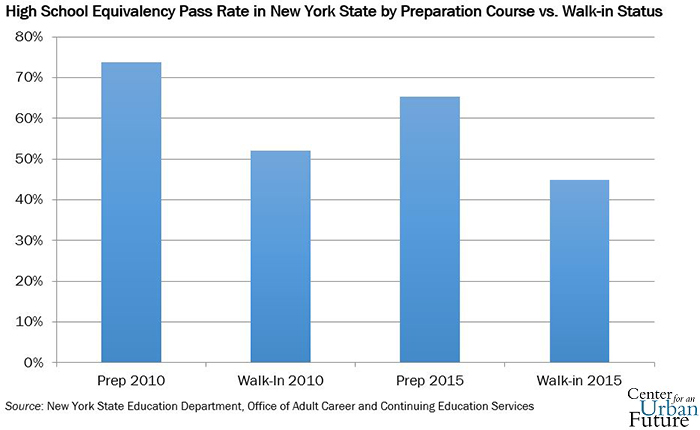

To view TASC pass rates in New York State by County in 2015, click here.
Image credit: Angelina Litvin











